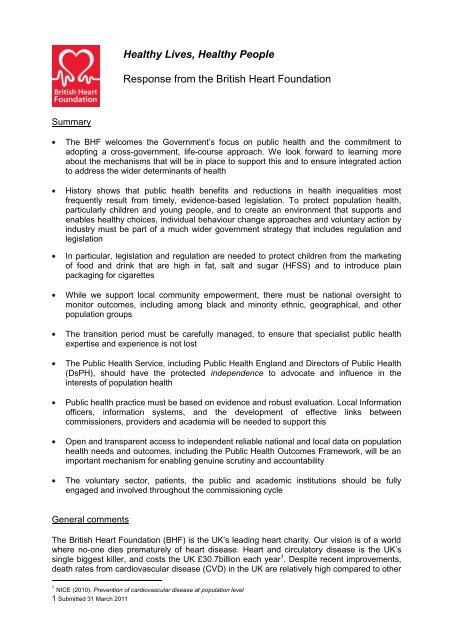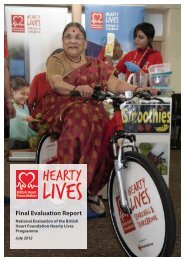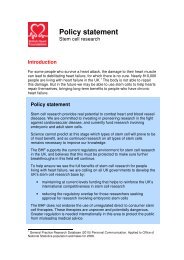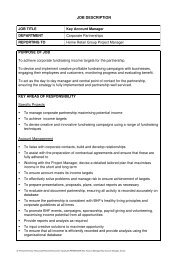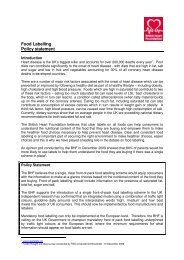BHF Response to Public Health White Paper - British Heart ...
BHF Response to Public Health White Paper - British Heart ...
BHF Response to Public Health White Paper - British Heart ...
Create successful ePaper yourself
Turn your PDF publications into a flip-book with our unique Google optimized e-Paper software.
<strong>Health</strong>y Lives, <strong>Health</strong>y People<br />
<strong>Response</strong> from the <strong>British</strong> <strong>Heart</strong> Foundation<br />
Summary<br />
The <strong>BHF</strong> welcomes the Government’s focus on public health and the commitment <strong>to</strong><br />
adopting a cross-government, life-course approach. We look forward <strong>to</strong> learning more<br />
about the mechanisms that will be in place <strong>to</strong> support this and <strong>to</strong> ensure integrated action<br />
<strong>to</strong> address the wider determinants of health<br />
His<strong>to</strong>ry shows that public health benefits and reductions in health inequalities most<br />
frequently result from timely, evidence-based legislation. To protect population health,<br />
particularly children and young people, and <strong>to</strong> create an environment that supports and<br />
enables healthy choices, individual behaviour change approaches and voluntary action by<br />
industry must be part of a much wider government strategy that includes regulation and<br />
legislation<br />
In particular, legislation and regulation are needed <strong>to</strong> protect children from the marketing<br />
of food and drink that are high in fat, salt and sugar (HFSS) and <strong>to</strong> introduce plain<br />
packaging for cigarettes<br />
While we support local community empowerment, there must be national oversight <strong>to</strong><br />
moni<strong>to</strong>r outcomes, including among black and minority ethnic, geographical, and other<br />
population groups<br />
The transition period must be carefully managed, <strong>to</strong> ensure that specialist public health<br />
expertise and experience is not lost<br />
The <strong>Public</strong> <strong>Health</strong> Service, including <strong>Public</strong> <strong>Health</strong> England and Direc<strong>to</strong>rs of <strong>Public</strong> <strong>Health</strong><br />
(DsPH), should have the protected independence <strong>to</strong> advocate and influence in the<br />
interests of population health<br />
<strong>Public</strong> health practice must be based on evidence and robust evaluation. Local Information<br />
officers, information systems, and the development of effective links between<br />
commissioners, providers and academia will be needed <strong>to</strong> support this<br />
Open and transparent access <strong>to</strong> independent reliable national and local data on population<br />
health needs and outcomes, including the <strong>Public</strong> <strong>Health</strong> Outcomes Framework, will be an<br />
important mechanism for enabling genuine scrutiny and accountability<br />
The voluntary sec<strong>to</strong>r, patients, the public and academic institutions should be fully<br />
engaged and involved throughout the commissioning cycle<br />
General comments<br />
The <strong>British</strong> <strong>Heart</strong> Foundation (<strong>BHF</strong>) is the UK’s leading heart charity. Our vision is of a world<br />
where no-one dies prematurely of heart disease. <strong>Heart</strong> and circula<strong>to</strong>ry disease is the UK’s<br />
single biggest killer, and costs the UK £30.7billion each year 1 . Despite recent improvements,<br />
death rates from cardiovascular disease (CVD) in the UK are relatively high compared <strong>to</strong> other<br />
1 NICE (2010). Prevention of cardiovascular disease at population level<br />
1 Submitted 31 March 2011
developed countries, and there is also considerable variation within the UK - geographically,<br />
ethnically and socially 2 .<br />
In more than 90% of cases, the risk of a first heart attack is related <strong>to</strong> potentially modifiable<br />
risk fac<strong>to</strong>rs, including smoking, poor diet, obesity/overweight, and insufficient physical activity 3 .<br />
We are pleased <strong>to</strong> see this Government focusing on public health.<br />
While we welcome the commitment <strong>to</strong> a ring-fenced budget, the scope of this budget needs<br />
clarification. The actual amount allocated <strong>to</strong> local authorities must be sufficient <strong>to</strong> enable<br />
DsPH <strong>to</strong> drive health improvement, and activities must not be re-badged as ‘public health’.<br />
A cross-Government approach<br />
There is a strong relationship between coronary heart disease (CHD) mortality rates and<br />
levels of deprivation. People from particular ethnic groups also suffer disproportionately from<br />
cardiovascular disease 4 and a number of related risk fac<strong>to</strong>rs; some but not all of this variation<br />
relates <strong>to</strong> deprivation.<br />
Measures <strong>to</strong> prevent heart disease and other non-communicable disease at a population level<br />
have co-benefits for a wide range of policy areas, including sustainable development, climate<br />
change, and poverty reduction.<br />
We welcome the commitment <strong>to</strong> addressing the ‘root causes of poor health and wellbeing’ and<br />
<strong>to</strong> adopting a cross-Government approach. We look forward <strong>to</strong> learning more about the<br />
mechanisms that will be in place <strong>to</strong> achieve this and enable <strong>Public</strong> <strong>Health</strong> England <strong>to</strong><br />
work closely with other Government departments. <strong>Health</strong> Impact Assessments and <strong>Health</strong><br />
Equity Impact Assessments should play a key role in cross-Government working.<br />
We support the commitment <strong>to</strong> improving the health of the poorest, fastest. To reduce the<br />
social gradient in health, actions must be universal, but with a scale and intensity that is<br />
proportionate <strong>to</strong> the level of disadvantage 5 . Greater consideration should be given <strong>to</strong> tackling<br />
health inequalities by ensuring a healthy standard of living for all.<br />
A life-course approach<br />
We support the Government’s commitment <strong>to</strong> adopting a life-course approach <strong>to</strong> public health.<br />
The Marmot Review clearly shows the effect of the early years (both pre-natally and preschool)<br />
on lifelong health and wellbeing, including heart disease and obesity 6 .<br />
A key aspect of this should be the promotion of healthy eating and physical activity<br />
from a young age. This is particularly important among high risk groups (for example the<br />
Marmot Review shows how obesity varies among different ethnic groups, and anticipates an<br />
increase in obesity among lower socio-economic groups) 7 .<br />
Daycare providers have a vital role in this, particularly as the number of under-5s in daycare<br />
and the length of time spent in daycare is increasing 8 . In our recent response <strong>to</strong> the Review of<br />
the Early Years Foundation Stage, we called for greater emphasis and specific learning goals<br />
on nutrition and healthy eating. The Framework should also incorporate the forthcoming<br />
guidelines around physical activity for the under-5s and details on what providers can do <strong>to</strong><br />
2 <strong>British</strong> <strong>Heart</strong> Foundation <strong>Health</strong> promotion Research Group (2010). Coronary <strong>Heart</strong> Disease Statistics 2010<br />
3 NICE (2010). Prevention of cardiovascular disease at population level<br />
4 The rate of CHD is one-third higher among men in the most deprived group compared with the least. The difference is even<br />
greater in women – those in the most deprived group have a rate of heart disease at least 50% greater than the least deprived<br />
group. South Asians living in the UK have a 50% greater risk of dying prematurely from CHD than the general population<br />
(www.heartstats.org.uk)<br />
5 Professor Sir Michael Marmot (2010). Fair Society, <strong>Health</strong>y Lives<br />
6 Ibid<br />
7 Ibid<br />
8 The Caroline Walker Trust (2006), Eating well for under-5s in childcare<br />
2 Submitted 31 March 2011
contribute <strong>to</strong> these, as well as providing greater clarity about what constitutes a ‘healthy,<br />
balanced and nutritious’ diet.<br />
Regular training is crucial <strong>to</strong> equip staff with the skills and knowledge <strong>to</strong> plan menus and<br />
prepare meals that meet nutritional requirements and <strong>to</strong> facilitate appropriate physical activity<br />
for this age group. Parents should also receive information about healthy eating and physical<br />
activity – the stage at which children start school is a prime opportunity for this. We welcome<br />
the commitment <strong>to</strong> increased numbers of health visi<strong>to</strong>rs.<br />
The <strong>White</strong> <strong>Paper</strong> gives helpful indications of what ‘good schools’ will do <strong>to</strong> promote health, but<br />
moni<strong>to</strong>ring must be in place <strong>to</strong> identify schools that are not meeting expectations and these<br />
should be offered high quality, evidence-based support and guidance. We welcome the<br />
commitment <strong>to</strong> supporting walking and cycling in schools, but we are concerned about the<br />
apparent focus on competition in sports and believe this may not be the best way <strong>to</strong> engage<br />
the least active.<br />
We understand that there will cease <strong>to</strong> be a nationally recognised <strong>Health</strong>y School Status and<br />
urge the Government <strong>to</strong> ensure that the necessary infrastructure and support is made<br />
available so schools can protect the health of children and young people. While food provided<br />
in schools will continue <strong>to</strong> be regulated by legislation, schools must be motivated <strong>to</strong> take<br />
broader action, including promoting healthy packed-lunches and healthy food purchased<br />
outside the school gates. We would welcome clarification about which body will have<br />
responsibility for moni<strong>to</strong>ring performance against existing school food standards.<br />
The Ladder of Interventions and the place for regulation<br />
The Government’s role in ensuring robust national, independent and transparent timelimited<br />
moni<strong>to</strong>ring of progress against Responsibility Deal pledges will be crucial.<br />
We firmly believe that complementary measures from different ‘rungs’ of the Ladder of<br />
Intervention 9 are needed – rather than starting with the least intrusive measures and<br />
progressing incrementally up the Ladder.<br />
The provision of information, behaviour change (‘nudging’), and voluntary action by industry<br />
will not on their own deliver the health outcomes <strong>to</strong> which we are all committed. Many aspects<br />
of the environment set the default options for behaviour and decision-making. The physical<br />
environment and commercial marketing, for example, can make positive health behaviours<br />
and healthy choices more difficult. In addition, while we recognise the importance of personal<br />
freedom and responsibility, this must be balanced with the need <strong>to</strong> protect population health,<br />
particularly among vulnerable groups including children who cannot be expected <strong>to</strong> take<br />
responsibility for their decisions.<br />
His<strong>to</strong>ry shows that public health benefits and reductions in health inequalities 10 most<br />
frequently result from timely, evidence-based legislation. This is shown, for example, by<br />
the seat belts legislation and the recent Review 11 of smokefree laws. We also believe that<br />
upstream whole system measures are the most cost-effective 12 .<br />
We were pleased <strong>to</strong> see the Tobacco Control Plan commit <strong>to</strong> the implementation of the<br />
legislation <strong>to</strong> prohibit the display of <strong>to</strong>bacco, and <strong>to</strong> consulting on plain packaging for<br />
cigarettes. Despite health warnings, packaging remains a ‘silent salesman’ for <strong>to</strong>bacco<br />
brands. We firmly believe that <strong>to</strong> increase the effectiveness of health warnings and<br />
9 Nuffield Council on Bioethics (2007). <strong>Public</strong> health: ethnics issues<br />
10 www.scotland.gov.uk/<strong>Public</strong>ations/2008/06/09160103/2<br />
11 University of Bath (2011). The impact of smokefree legislation in England: Evidence Review<br />
12 For more information, please see the evidence-based cost-effective upstream measures recommended in NICE (2010).<br />
Prevention of cardiovascular disease at population level<br />
3 Submitted 31 March 2011
address misconceptions about the risks of smoking, legislation is needed <strong>to</strong> introduce<br />
plain packaging for cigarettes across the UK.<br />
Legislation and regulation is also needed <strong>to</strong> protect children and young people from the harm<br />
caused by the marketing of food and drink that is high in fat, salt, and sugar (HFSS food and<br />
drink). Although the advertising of HFSS foods and drinks is prohibited during children’s<br />
programming, a recent review by Ofcom 13 showed that just over half of children’s viewing time<br />
is in commercial adult airtime (when programmes such as X fac<strong>to</strong>r, and Britain’s Got Talent<br />
are shown). A complete ban on HFSS advertising and product placement before 9pm<br />
would offer better protection from slick marketing campaigns, and legislation and<br />
independent regulation should also be applied <strong>to</strong> non-broadcast media - the internet, in<br />
print, and on food packaging.<br />
The role of the centre<br />
The ambition <strong>to</strong> keep ‘<strong>to</strong> a minimum constraints as <strong>to</strong> how local government decides <strong>to</strong> fulfil its<br />
public health role’ will need <strong>to</strong> be carefully balanced with the requirement <strong>to</strong> deliver evidencebased<br />
and equitable interventions and outcomes. The action taken by local authorities will<br />
inevitably vary, and the Government will need <strong>to</strong> moni<strong>to</strong>r outcomes among geographical,<br />
black and minority ethnic, and other population groups, and take responsibility for<br />
ensuring that action is taken where unacceptable variation in outcome persists. We<br />
would welcome more information about the process for making sure that this happens.<br />
The <strong>Public</strong> <strong>Health</strong> Service, including <strong>Public</strong> <strong>Health</strong> England and DsPH (see below) should<br />
have the protected independence <strong>to</strong> advocate and influence national and local government<br />
and the NHS. We have concerns about how <strong>Public</strong> <strong>Health</strong> England will achieve this level<br />
of independence if it is a fully-integrated part of the Department of <strong>Health</strong>.<br />
The provision of public health guidance and national minimum standards (such as the<br />
school food standards) <strong>to</strong> support local decision-making will be crucial. We welcome<br />
the commitment <strong>to</strong> providing local areas with evidence on how ‘<strong>to</strong> make regular physical<br />
activity and healthy food choices easier for their populations’.<br />
DsPH should work <strong>to</strong> implement NICE public health guidance, including guidance on the<br />
prevention of cardiovascular disease 14 , prevention of overweight and obesity 15 , and on<br />
physical activity and the environment 16 . We would like more information on which bodies will<br />
pick up those pieces of guidance that have been removed from the NICE work programme,<br />
including aspects of <strong>to</strong>bacco guidance and spatial planning for health. NICE should also<br />
review upstream national and international public health measures (it should not just focus on<br />
local interventions).<br />
The new responsibilities of local authorities and DsPH<br />
We welcome the transfer of local public health leadership <strong>to</strong> local government. However, the<br />
transition period must be carefully managed <strong>to</strong> ensure that current specialist public<br />
health expertise and experience is not lost. The forthcoming <strong>Public</strong> <strong>Health</strong> Workforce<br />
Strategy should give careful consideration <strong>to</strong> ensuring a coordinated approach <strong>to</strong> workforce<br />
training and supply, and should consider not just DsPH but those who work in jobs that have a<br />
bearing on health (such as planning and transport).<br />
DsPH are exciting roles with great potential <strong>to</strong> tackle the wide range of social determinants of<br />
health and health inequalities. To achieve this however, they must have the protected<br />
independence, authority and resources <strong>to</strong> advocate and influence all policy areas that<br />
13 Ofcom (2010). HFSS advertising restrictions - Final review<br />
14 NICE (2010). Prevention of cardiovascular disease at population level<br />
15 NICE (2006). Obesity. Guidance on the prevention, identification, assessment and management of overweight and obesity in<br />
adults and children<br />
16 NICE (2008). Promoting and creating built or natural environments that encourage and support physical activity<br />
4 Submitted 31 March 2011
have a bearing on health and health inequalities. Committed, strong and stable leadership<br />
will be needed <strong>to</strong> develop new working cultures.<br />
The <strong>Health</strong> and Social Care Bill must therefore require DsPH <strong>to</strong> have Executive Direc<strong>to</strong>r<br />
status (second tier officers), reporting directly <strong>to</strong> the Chief Executive in the Local Authority.<br />
The Bill should also set out the statu<strong>to</strong>ry roles of DsPH including being a formal consultee,<br />
advocate and advisor on all policy areas and functions that have a bearing on health (such as<br />
planning, education and transport).<br />
Forthcoming <strong>Public</strong> <strong>Health</strong> Plans<br />
We recognise that the <strong>Public</strong> <strong>Health</strong> <strong>White</strong> <strong>Paper</strong> provides the overall public health framework<br />
and that more detail in particular policy areas will be provided in associated <strong>Public</strong> <strong>Health</strong><br />
plans.<br />
Social marketing<br />
Population-level information is crucial <strong>to</strong> support people in making healthy choices. We look<br />
forward <strong>to</strong> reading more in the forthcoming Social Marketing Plan about how healthy diets,<br />
physical activity, smoking cessation and smoke-free homes and cars will be promoted through<br />
the forthcoming Social Marketing Plan.<br />
The Plan must give particular consideration <strong>to</strong> the need for dedicated interventions and<br />
awareness campaigns for disadvantaged groups that suffer disproportionately from<br />
cardiovascular disease, including some black and minority ethnic groups.<br />
Obesity and Physical Activity<br />
We would have liked <strong>to</strong> see greater reference in the <strong>White</strong> <strong>Paper</strong> <strong>to</strong> measures <strong>to</strong> promote<br />
healthy diets and hope <strong>to</strong> see more detail in the forthcoming Obesity Plan. In particular we<br />
would like <strong>to</strong> see proposals for legislation and regulation <strong>to</strong> protect children from junk food<br />
marketing. We also look forward <strong>to</strong> learning more about the Government’s plans <strong>to</strong> promote<br />
physical activity and active travel in the Physical Activity Plan.<br />
We strongly agree that active travel and physical activity need <strong>to</strong> become the norm in<br />
communities and welcome the recognition that ‘improving the environment in which people<br />
live can make healthy lifestyles easier.’ Access <strong>to</strong> local parks and safe outside space and a<br />
reduction in the speed limit <strong>to</strong> 20 miles per hour in residential areas are key <strong>to</strong> enabling people<br />
<strong>to</strong> build physical activity in<strong>to</strong> their daily lives. We support Sustrans’ call for public health<br />
objectives <strong>to</strong> be reflected in the Department for Transport’s Local Sustainable Transport Fund<br />
bid selection criteria.<br />
Information about the nutritional content of food is also crucial <strong>to</strong> create an environment that<br />
enables consumers <strong>to</strong> make healthy choices. Research has shown that front of pack (FOP)<br />
labels including traffic light colours, the words ‘high’, ‘medium’ and ‘low’, and percentage<br />
guideline daily amounts help consumers tell at-a-glance what’s in the food they’re buying 17 .<br />
Traffic light labels can also help drive product reformulation, which is an important way of<br />
reducing levels of saturated fat, salt and sugar consumption.<br />
Developments concerning food labelling legislation at European Union level mean that<br />
additional voluntary labelling schemes are likely <strong>to</strong> go ahead, and it is important that the UK<br />
Government supports this <strong>to</strong> allow the continuation of FOP labels in the UK. It is proposed that<br />
additional voluntary schemes will give member states the opportunity <strong>to</strong> endorse a particular<br />
labelling scheme. The UK Government should therefore strongly support and encourage<br />
the use of the Food Standards Agency’s Multiple Traffic Light FOP labelling system, <strong>to</strong><br />
help consumers get the most out of FOP labels. Those companies choosing <strong>to</strong> use their<br />
own labelling schemes must provide independent and transparent evidence <strong>to</strong> demonstrate<br />
that these are effective.<br />
17 http://www.food.gov.uk/news/newsarchive/2009/may/pmp<br />
5 Submitted 31 March 2011
We are pleased that work is underway on the provision of nutritional information at the point<br />
where decisions are made in cafes and restaurants, and hope <strong>to</strong> see this extended <strong>to</strong> give<br />
consumers more comprehensive information about the nutritional content of foods<br />
rather than just the energy content. This is particularly crucial given that one in six meals<br />
are now eaten outside the home 18 .<br />
To eliminate industrial trans fats, action will be needed across small and medium-sized<br />
catering businesses, as well as large suppliers, manufacturers and providers. If voluntary<br />
action is unsuccessful, the Government must take legislative action <strong>to</strong> remove trans<br />
fats. Additional work is also urgently needed <strong>to</strong> substantially reduce saturated fat<br />
consumption.<br />
We understand that the Responsibility Deal targets for salt reduction are equivalent <strong>to</strong> the FSA<br />
2012 targets. However, further ongoing action by manufacturers, retailers and caterers<br />
will be essential <strong>to</strong> reduce salt consumption <strong>to</strong> recommended levels.<br />
The crucial role of the NHS in public health<br />
The role of the NHS in both primary and secondary prevention must continue <strong>to</strong> be<br />
recognised, and NHS health professionals must see this as part of their role and responsibility.<br />
We are pleased that the NHS Commissioning Board will retain a public health role, and<br />
welcome the recognition of the need for close working with <strong>Public</strong> <strong>Health</strong> England.<br />
<strong>Health</strong> and Wellbeing Boards will play an important role in facilitating collaboration between<br />
DsPH and GP commissioning consortia.<br />
All NHS services should work <strong>to</strong> tackle health inequalities by promoting equitable access <strong>to</strong><br />
services (for example, ensuring these are culturally appropriate).<br />
Promoting advanced care planning<br />
We welcome the recognition of the affect of end of life care on the physical and psychological<br />
health of family and carers.<br />
Many people with heart failure want <strong>to</strong> die in their own home, but most die in hospital 19 .<br />
Having a conversation about end of life care is crucial <strong>to</strong> meeting patients’ needs and wishes,<br />
yet in many cases, these conversations do not happen 20 . Advanced care planning is a process<br />
through which a person can express preferences for future care, in discussion with their<br />
family, main carer, and professionals. This might include, for example, explaining where they<br />
want <strong>to</strong> be cared for, who they want <strong>to</strong> act on their behalf if the person is unable <strong>to</strong> make their<br />
own decisions, and how they want their religious or spiritual beliefs or cultural preferences <strong>to</strong><br />
be reflected in their care. Training for healthcare professionals on how <strong>to</strong> discuss end of life<br />
care is crucial.<br />
Clinical and social care needs assessments should be conducted with every person<br />
approaching the end of their life, and a key worker should manage any changes in condition.<br />
Patients should be supported by a care co-ordina<strong>to</strong>r <strong>to</strong> organise and streamline appointments<br />
and follow up requests for equipment (this could be the same person or could be someone<br />
non-clinical, such as an informal carer). 24/7 access <strong>to</strong> nursing, pain relief and specialist<br />
advice is also crucial <strong>to</strong> meeting patients’ wishes for end of life care.<br />
Screening for heart conditions<br />
18 Defra (2008). Family Food Survey<br />
19 <strong>British</strong> <strong>Heart</strong> Foundation (2010). Better Together, An end of life initiative for patients with heart failure and their families,<br />
Executive Summary<br />
20 For more information please see: www.dyingmatters.org<br />
6 Submitted 31 March 2011
Throughout the <strong>White</strong> <strong>Paper</strong> and associated consultations, there is a notable absence of<br />
reference <strong>to</strong> congenital heart disease, despite this being the most commonly occurring<br />
major congenital abnormality affecting one in every 145 babies 21 . Effective routine screening<br />
ante-natally and post-partum is crucial, and audit and specialist professional training are<br />
needed <strong>to</strong> support this.<br />
There is also a lack of reference <strong>to</strong> inherited cardiac conditions. Familial<br />
hypercholesterolaemia (FH) is an inherited condition which causes high blood cholesterol<br />
levels and a greatly heightened risk of heart disease. If FH is identified and treated early, life<br />
expectancy can be normal, but if left untreated roughly half of men will develop heart disease<br />
by 55 and around a third of women by the age of 60. Currently there are around 100,000<br />
undiagnosed people in the UK at risk of heart disease due <strong>to</strong> FH 22 . NICE has recommended<br />
the implementation of cascade screening whereby first degree relatives of known FH sufferers<br />
are screened for the genetic defect and managed appropriately if found <strong>to</strong> be affected. Other<br />
inherited cardiac conditions include inherited cardiac arrhythmias, cardiomyopathies, muscular<br />
dystrophies, and other connective tissue disorders, such as marfan’s syndrone.<br />
We understand that screening is <strong>to</strong> be commissioned by the NHS Commissioning Board,<br />
while the birth anomaly register will be organised and maintained by local authorities and<br />
<strong>Public</strong> <strong>Health</strong> England. We support the recommendation of the Genetic Alliance for the<br />
commissioning of screening and the maintenance of the register <strong>to</strong> be more closely aligned.<br />
The <strong>BHF</strong> welcomes the ongoing national roll-out of NHS abdominal aortic aneurysm<br />
screening, and the commitment <strong>to</strong> national coverage by 2012/13.<br />
<strong>Response</strong>s <strong>to</strong> specific consultation questions<br />
Qa. Are there additional ways in which we can ensure that GPs and GP practices will continue<br />
<strong>to</strong> play a key role in areas for which <strong>Public</strong> <strong>Health</strong> England will take responsibility<br />
We welcome the intention <strong>to</strong> increase the role of general practice in public health, including<br />
ensuring that public health activity is appropriately reflected in the Quality and Outcomes<br />
Framework (QOF). We also support the proposal <strong>to</strong> include public health in the education and<br />
training of GPs and believe this should be extended <strong>to</strong> the whole primary healthcare team.<br />
General practice teams have a crucial role in sign-posting and referring <strong>to</strong> health promotion<br />
programmes and services, for example <strong>to</strong> promote physical activity and healthy eating. GP<br />
consortia and DsPH will need <strong>to</strong> work closely <strong>to</strong>gether <strong>to</strong> ensure that there is clarity around<br />
how, and from whom, these services are commissioned and funded.<br />
Qb. What are the best opportunities <strong>to</strong> develop and enhance the availability, accessibility and<br />
utility of public health information and intelligence<br />
We welcome the recognition that ‘<strong>Public</strong> health evaluation and research will be critical in<br />
enabling public health practice <strong>to</strong> develop in<strong>to</strong> the future and address key challenges and<br />
opportunities’. There should be a statu<strong>to</strong>ry duty <strong>to</strong> promote public health and health<br />
research throughout the new public health and health structures, including GP consortia.<br />
The focus on localism must not impede the commissioning of national public health research.<br />
There is currently a gap between public health research and the provision of public health<br />
services. Local commissioning structures and providers will need effective<br />
relationships with both the National Institute for <strong>Health</strong> Research (NIHR) and academic<br />
institutions that conduct research.<br />
21 Petersen S., Pe<strong>to</strong> V., and Rayner M. (2003). Congenital heart disease statistics<br />
22 Royal College of Physicians (2010). The National Audit of the Management of Familial Hypercholesterolaemia<br />
7 Submitted 31 March 2011
<strong>Public</strong> health knowledge management systems are also crucial <strong>to</strong> ensure evidencebased<br />
practice. The roles of information officers should be protected, maintained and<br />
developed. Frameworks and guidance on the evaluation of ‘what works’ should also be<br />
developed and disseminated.<br />
Clarification is needed about the future of public health observa<strong>to</strong>ries.<br />
Open access <strong>to</strong> independent reliable national and local data on population health needs<br />
and outcomes, including the <strong>Public</strong> <strong>Health</strong> Outcomes Framework, will be an important<br />
mechanism for enabling genuine scrutiny and accountability. This should include making<br />
available local data on physical activity levels among children and young people and<br />
maintaining the Local Tobacco Profiles. National lifestyle surveys should continue <strong>to</strong> be<br />
supported and funded so behaviour trends in different population groups can be moni<strong>to</strong>red.<br />
We are pleased <strong>to</strong> see that the National Child Measurement Programme will continue.<br />
We are pleased that the <strong>Health</strong> and Social Care Bill requires GP consortia and the NHS<br />
Commissioning Board <strong>to</strong> have regard for Joint Strategic Needs Assessment (JSNAs) when<br />
drawing up their plans. There must be a clear, publicly accessible audit trail leading from<br />
population JSNA, through <strong>to</strong> service design, service implementation, moni<strong>to</strong>ring and review.<br />
The effectiveness of this process will depend on close partnership working and data-sharing<br />
between DsPH and GP commissioning consortia.<br />
Qd. What can wider partners nationally and locally contribute <strong>to</strong> improving the use of evidence<br />
in public health<br />
During this period of significant organisational change, the voluntary sec<strong>to</strong>r and academic<br />
institutions remain a constant and lasting source of expertise and evidence on the<br />
effectiveness of public health interventions. As activity is increasingly devolved <strong>to</strong> a local level,<br />
national voluntary sec<strong>to</strong>r organisations also play an important role in identifying and<br />
disseminating local good practice, and exploring the needs of population groups across<br />
organisational boundaries.<br />
Case study – The work of the <strong>British</strong> <strong>Heart</strong> Foundation <strong>to</strong> improve heart health<br />
The <strong>BHF</strong> delivers a number of innovative community outreach projects that work directly with<br />
communities with a high risk of heart disease. Through our £9 million <strong>Heart</strong>y Lives 23<br />
programme we are working in partnership with health, local authority and community<br />
organisations <strong>to</strong> tackle inequalities in heart disease. In Bris<strong>to</strong>l, for example, we are investing<br />
£100,000 in helping children’s centres throughout the city <strong>to</strong> encourage families <strong>to</strong> adopt<br />
healthier lifestyles, working in close partnership with NHS Bris<strong>to</strong>l and Bris<strong>to</strong>l City Council.<br />
We also run outreach projects that promote healthy lifestyles <strong>to</strong> the South Asian population. In<br />
2010, the <strong>BHF</strong> attended ten Melas - South Asian cultural fairs - across the country, and<br />
through our annual Ramadan campaign we help people from Muslim communities <strong>to</strong> make<br />
positive lifestyle changes including through working with local mosques.<br />
Over the last two years we have also been running projects and developing resources <strong>to</strong> raise<br />
awareness of heart health among African Caribbean communities, including through working<br />
with black barber shops, and at events including the Afro Hair and Beauty Show and the Jerk<br />
Cookout Festival.<br />
Meanwhile, our annual Food4Thought campaign aims <strong>to</strong> encourage 11-13 year old children <strong>to</strong><br />
take greater responsibility for their health, and <strong>to</strong> create an environment where bad food<br />
influences are minimised. This year will be the sixth year of the campaign which has involved<br />
23<br />
For more information, please see: www.bhf.org.uk/heart-health/how-we-help/in-your-area/hearty-lives.aspx<br />
8 Submitted 31 March 2011
‘Ultimate Dodgeball’ events, and children creating their own ‘Yoobots’ - a mini digital version of<br />
themselves that shows how choice of food and lifestyle affects health 24 .<br />
The <strong>BHF</strong> <strong>Health</strong> at Work programme 25 provides free ideas, information, <strong>to</strong>ols, and advice for<br />
organisations <strong>to</strong> develop their own ‘health club’ at work. Our guides suggest simple steps that<br />
workplace health coordina<strong>to</strong>rs can take <strong>to</strong> help support their workforce <strong>to</strong> make positive<br />
lifestyle changes.<br />
The <strong>BHF</strong> also funds a number of specialist organisations which focus on public health<br />
research. This includes the <strong>BHF</strong> National Centre for Physical Activity and <strong>Health</strong> at the<br />
University of Loughborough, and the <strong>BHF</strong> <strong>Health</strong> Promotion Research Group at the University<br />
of Oxford.<br />
In addition, we play a key role in translating evidence in<strong>to</strong> practice through the provision of<br />
information and support for patients and the public. We produce a wide range of free <strong>to</strong>ols,<br />
resources and services that educate and empower people <strong>to</strong> protect and improve their heart<br />
health, including the <strong>BHF</strong> <strong>Heart</strong> HelpLine 26 and free <strong>Heart</strong> Matters 27 service (providing<br />
members with a magazine and online lifestyle check).<br />
The different commissioning bodies, including <strong>Public</strong> <strong>Health</strong> England, the NHS<br />
Commissioning Board and GP consortia should engage with the voluntary sec<strong>to</strong>r so<br />
they can share insights, evidence and expertise.<br />
National and local commissioning policy and guidance should also recognise the role of major<br />
national charities as commissioners and co-inves<strong>to</strong>rs in the health and wellbeing of local<br />
communities, and not just as providers of services.<br />
Charities, patients, the public and academic institutions should be fully engaged and involved<br />
throughout the commissioning cycle, from the development of the Joint Strategic Needs<br />
Assessment through mapping needs against existing provision, service planning, re-design,<br />
service specification and contracting, delivery, moni<strong>to</strong>ring and evaluation. <strong>Health</strong> and<br />
Wellbeing Boards should be responsible for ensuring that this happens.<br />
To play our part in the Big Society and invest resources most effectively charities like the <strong>BHF</strong><br />
must have open access <strong>to</strong> independent data on trends in population behaviour, for example<br />
through the <strong>Public</strong> <strong>Health</strong> Outcomes Framework and National Lifestyle Surveys.<br />
The <strong>BHF</strong> would welcome the opportunity <strong>to</strong> provide additional information <strong>to</strong> support the<br />
Government in developing and implementing its proposals.<br />
For more information, please contact policy@bhf.org.uk<br />
24 For more information, please see: www.yoobot.co.uk/yoobot.html<br />
25 http://www.bhf.org.uk/Thinkfit/default.aspxpage=0<br />
26 HelpLine team is made up of cardiac nurses, heart health advisers, and a bereavement counsellor, and around 3000 enquiries<br />
each month are handled by telephone, email, and letter<br />
27 For more information, please see: www.bhf.org.uk/heart-health/how-we-help/information/heart-matters.aspx<br />
9 Submitted 31 March 2011


